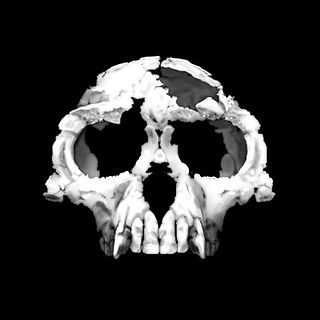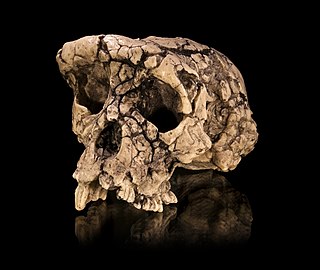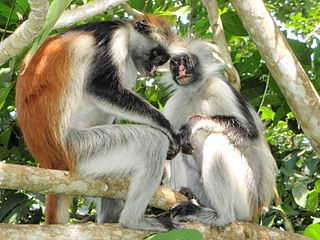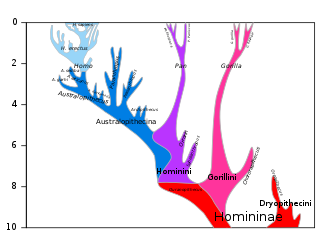Related Research Articles

Ardipithecus is a genus of an extinct hominine that lived during the Late Miocene and Early Pliocene epochs in the Afar Depression, Ethiopia. Originally described as one of the earliest ancestors of humans after they diverged from the chimpanzees, the relation of this genus to human ancestors and whether it is a hominin is now a matter of debate. Two fossil species are described in the literature: A. ramidus, which lived about 4.4 million years ago during the early Pliocene, and A. kadabba, dated to approximately 5.6 million years ago. Behavioral analysis showed that Ardipithecus could be very similar to chimpanzees, indicating that the early human ancestors were very chimpanzee-like in behavior.

The chimpanzee, also known as the common chimpanzee, robust chimpanzee, or simply "chimp", is a species of great ape native to the forests and savannahs of tropical Africa. It has four confirmed subspecies and a fifth proposed subspecies. The chimpanzee and the closely related bonobo are classified in the genus Pan. Evidence from fossils and DNA sequencing shows that Pan is a sister taxon to the human lineage and is humans' closest living relative.

Homininae, also called "African hominids" or "African apes", is a subfamily of Hominidae. It includes two tribes, with their extant as well as extinct species: 1) the Hominini tribe ―and 2) the Gorillini tribe (gorillas). Alternatively, the genus Pan is sometimes considered to belong to its own third tribe, Panini. Homininae comprises all hominids that arose after orangutans split from the line of great apes. The Homininae cladogram has three main branches, which lead to gorillas, and to humans and chimpanzees via the tribe Hominini and subtribes Hominina and Panina. There are two living species of Panina and two living species of gorillas, but only one extant human species. Traces of hypothetical Homo species, including Homo floresiensis and Homo denisova, have been found with dates as recent as 40,000 years ago. Organisms in this subfamily are described as hominine or hominines.

The bonobo, also historically called the pygmy chimpanzee and less often, the dwarf or gracile chimpanzee, is an endangered great ape and one of the two species making up the genus Pan; the other being the common chimpanzee. Although bonobos are not a subspecies of chimpanzee, but rather a distinct species in their own right, both species are sometimes referred to collectively using the generalized term chimpanzees, or chimps. Taxonomically, the members of the chimpanzee/bonobo subtribe Panina are collectively termed panins.

Dame Jane Morris Goodall, formerly Baroness Jane van Lawick-Goodall, is an English primatologist and anthropologist. Considered to be the world's foremost expert on chimpanzees, Goodall is best known for her over 55-year study of social and family interactions of wild chimpanzees since she first went to Gombe Stream National Park in Tanzania in 1960.

Sahelanthropus tchadensis is an extinct species of the Homininae dated to about 7 million years ago, during the Miocene epoch. The species, and its genus Sahelanthropus, was announced in 2002, based mainly on a partial cranium, nicknamed Toumaï, discovered in northern Chad.

The genus Pan consists of two extant species: the common chimpanzee and the bonobo. Taxonomically, these two ape species are collectively termed panins; however, both species are more commonly referred to collectively using the generalized term chimpanzees, or chimps. Together with humans, gorillas, and orangutans they are part of the family Hominidae. Native to sub-Saharan Africa, common chimpanzees and bonobos are currently both found in the Congo jungle, while only the common chimpanzee is also found further north in West Africa. Both species are listed as endangered on the IUCN Red List of Threatened Species, and in 2017 the Convention on Migratory Species selected the common chimpanzee for special protection.

Cheeta is a chimpanzee character that appeared in numerous Hollywood Tarzan films of the 1930s–1960s, as well as the 1966–1968 television series, as the ape sidekick of the title character, Tarzan. Cheeta has usually been characterized as male, but sometimes as female, and has been portrayed by chimpanzees of both sexes.
Yerkish is an artificial language developed for use by non-human primates. It employs a keyboard whose keys contain lexigrams, symbols corresponding to objects or ideas.
The humanzee is a hypothetical chimpanzee/human hybrid. An unsuccessful attempt to create such a hybrid was made by Ilya Ivanovich Ivanov in the 1920s. The portmanteau word humanzee for a human–chimpanzee hybrid appears to have entered usage in the 1980s.

The Hominini, or hominins, form a taxonomic tribe of the subfamily Homininae ("hominines"). Hominini includes the genus Homo (humans), but excludes the genus Gorilla (gorillas). As of 2020, there is no consensus on whether it should include the genus Pan, the question being closely tied to the complex speciation process connecting humans and chimpanzees and the development of bipedalism in proto-humans.

Richard Walter Wrangham is a British primatologist. His research and writing have involved ape behavior, human evolution, violence, and cooking.

Red colobuses are Old World monkeys of the genus Piliocolobus. It was formerly considered a subgenus within the genus Procolobus, which is now restricted to the olive colobus. They are closely related to the black-and-white colobus monkeys, and some species are often found in groups with the blue monkey. The western red colobus is frequently hunted by the common chimpanzee.

Roger S. Fouts is a retired American primate researcher. He was co-founder and co-director of the Chimpanzee and Human Communication Institute (CHCI) in Washington, and a professor of psychology at the Central Washington University. He is best known for his role in teaching Washoe the chimpanzee to communicate using a set of signs taken from American sign language.

The Hominidae, whose members are known as great apes or hominids, are a taxonomic family of primates that includes eight extant species in four genera: Pongo, the Bornean, Sumatran and Tapanuli orangutan; Gorilla, the eastern and western gorilla; Pan, the common chimpanzee and the bonobo; and Homo, of whom only modern humans remain, with several extinct relatives and ancestors, such as Homo erectus.
Christophe Boesch is a primatologist who studies chimpanzees. He and his wife work together, and he has both written articles and directed documentaries about chimpanzees.

The Kasakela chimpanzee community is a habituated community of wild eastern chimpanzees that lives in Gombe National Park near Lake Tanganyika in Tanzania. The community was the subject of Dr. Jane Goodall's pioneering study that began in 1960, and studies have continued ever since, becoming the longest continuous study of any animals in their natural habitat. As a result, the community has been instrumental in the study of chimpanzees and has been popularized in several books and documentaries. The community's popularity was enhanced by Goodall's practice of giving names to the chimpanzees she was observing, in contrast to the typical scientific practice of identifying the subjects by number. Goodall generally used a naming convention in which infants were given names starting with the same letter as their mother, allowing the recognition of matrilineal lines.

The chimpanzee–human last common ancestor, or CHLCA, is the last common ancestor shared by the extant Homo (human) and Pan genera of Hominini. Due to complex hybrid speciation, it is not possible to give a precise estimate on the age of this ancestral population. While "original divergence" between populations may have occurred as early as 13 million years ago (Miocene), hybridization may have been ongoing until as recently as 4 million years ago (Pliocene).
The species Taï Forest ebolavirus is a virological taxon included in the genus Ebolavirus, family Filoviridae, order Mononegavirales. The species has a single virus member, Taï Forest virus (TAFV). The members of the species are called Taï Forest ebolaviruses.
The New England Anti-Vivisection Society (NEAVS) is a national, registered 501(c)(3) nonprofit organization “dedicated to ending the use of animals in research, testing, and science education” and replacing them with "modern alternatives that are ethically, humanely, and scientifically superior."
References
- ↑ "Rapport d'activité 2004-2006" (PDF). Centre suisse de recherches scientifiques en Côte d'Ivoire (in French). Swiss Academy of Natural Sciences (SCNAT).